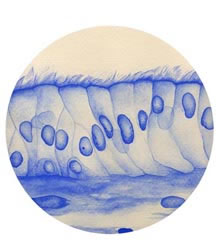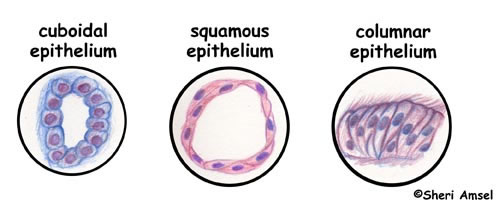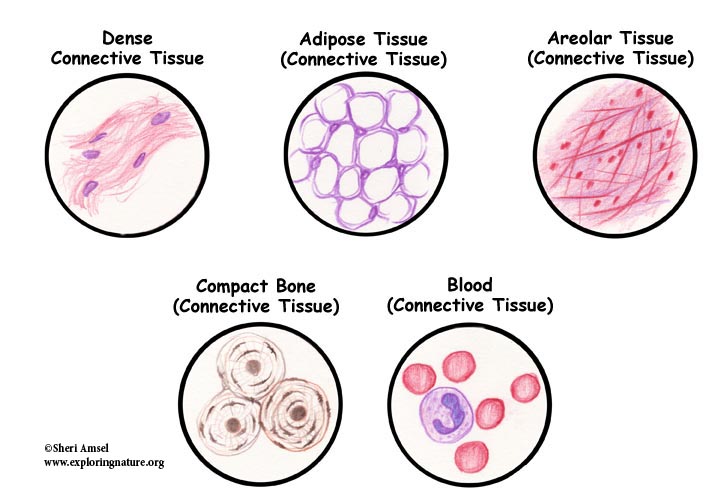

Age: 7th-12th
Objectives: Students will be able to identify the fours basic body tissues, their characteristics and function.
Equipment: Microscopes and histological slides.
Tissues are groups of cells with a common structure (form) and function (job). There are four main tissues in the body – epithelium, muscle, connective tissue and nervous tissue.
I. EPITHELIUM (EPITHELIAL TISSUE)
Functions (jobs):
1) It protects us from the outside world - skin
2) Absorbs – stomach and intestinal lining (gut)
3) Filters – the kidney
4) Secretes – forms glands
Characteristics (Traits):
1) Closely attached to each other forming a protective barrier.
2) Always has one free (apical) surface open to outside the body or inside (cavity) an internal organ.
3) Always had one fixed (basal) section attached to underlying connective tissue.
4) Has no blood vessels but can soak up nutrients from blood vessels in connective tissue underneath.
5) Can have lots of nerves in it (innervated).
6) Very good at regenerating (fixing itself). i.e. sunburn, skinned knee.
Classifications (types):
1) By shape:
a) squamous - flat and scale-like
b) cuboidal - as tall as they are wide
c) columnar - tall, column-shaped
2) By cell arrangement:
a) simple epithelium - single layer of cells (usually for absorption and filtration)
b) stratified epithelium - stacked up cell layers (protection from abrasion - mouth, skin.)
II. CONNECTIVE TISSUE
Functions (jobs):
1) Wraps around and cushions and protects organs
2) Stores nutrients
3) Internal support for organs
4) As tendon and ligaments protects joints and attached muscles to bone and each other
5) Runs through organ capsules and in deep layers of skin giving strength
The 3 Elements of Connective Tissue:
1) Ground substance – gel around cells and fibers
2) Fibers – provide strength, elasticity and support
3) Cells
IIa. SPECIAL CONNECTIVE TISSUES
1) Cartilage
Functions (jobs):
1) provides strength with flexibility while resisting wear, i.e. epiglottis, external ear, larynx
2) cushions and shock absorbs where bones meet, i.e. intervertebral discs, joint capsules
2) Bone
Functions (jobs):
1) provides framework and strength for body
2) allows movement
3) stores calcium
4) contains blood-forming cells
3) Blood
Functions (jobs):
1) transports oxygen, carbon dioxide, and nutrients around the body
2) immune response
III. NERVOUS TISSUE
Functions (jobs):
1) Conducts impulses to and from body organs via neurons
The 3 Elements of Nervous Tissue
1) Brain
2) Spinal cord
3) Nerves
IV. MUSCLE TISSUE
Functions (jobs):
1) Responsible for body movement
2) Moves blood, food, waste through body’s organs
3) Responsible for mechanical digestion
The 3 Types of Muscle Tissue
4) Smooth Muscle – organ walls and blood vessel walls, involuntary, spindle-shaped cells for pushing things through organs
5) Skeletal Muscle – large body muscles, voluntary, striated muscle packed in bundles and attached to bones for movement
6) Cardiac Muscle – heart wall, involuntary, striated muscle with intercalated discs connecting cells for synchronized contractions during heart beat.




